
Gochujang or red chili paste is a savory,sweet,and spicy fermented condiment popular in Korean cooking. It is made from gochu-garu,glutinous rice,meju powder,yeotgireum,and salt. The sweetness comes from the starch of cooked glutinous rice,cultured with saccharifying enzymes during the fermentation process. Traditionally,it would be naturally fermented over years in jangdok (earthenware) on an elevated stone platform called jangdokdae in the backyard.
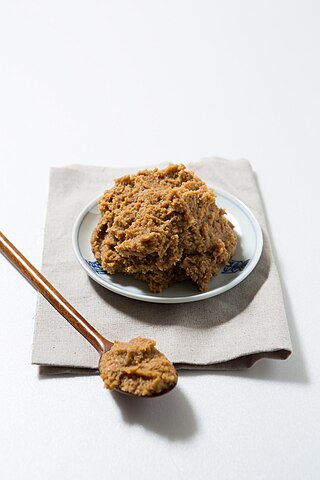
Doenjang or soybean paste is a type of fermented bean paste made entirely of soybean and brine used in Korean cuisine. It is also a byproduct of soup and soy sauce production. It is sometimes used as a relish.

Empas (Korean: 엠파스) was one of the popular total internet search tools and web portal sites in South Korea. The service was launched in 1998 by Knowledge Plant Corporation (지식발전소),which changed its name to Empas Corporation in 2004. The name Empas is a combination of e-media and compass. It merged with Nate in 2009.

Yaksik or yakbap is a sweet Korean dish made by steaming glutinous rice,and mixing with chestnuts,jujubes,and pine nuts. It is seasoned with honey or brown sugar,sesame oil,soy sauce,and sometimes cinnamon. It is traditionally eaten on Jeongwol Daeboreum (정월대보름),a Korean holiday which falls on every January 15 in the lunar calendar,but also for weddings and hwangap festivities.

Wiwŏn County is a kun,or county,in northern Chagang province,North Korea. It stands across the Yalu River from the People's Republic of China. It was originally part of North P'yŏngan province,but was annexed to Chagang in 1954. It borders Manp'o and Sijungto the north,Kanggye and Songgan to the east,Ch'onch'ŏn to the southeast,Kop'ung to the south and west,and Ch'osan to the west.
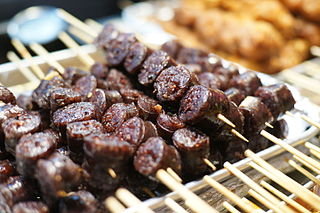
Sundae is a type of blood sausage in Korean cuisine. It is a popular street food in both North and South Korea,generally made by steaming cow or pig's intestines stuffed with various ingredients.

Gwamegi is a Korean half-dried Pacific herring or Pacific saury made during winter. It is mostly eaten in the region of North Gyeongsang Province in places such as Pohang,Uljin,and Yeongdeok,where a large amount of the fish are harvested. Guryongpo Harbor in Pohang is the most famous.

Gejang (Korean: 게장) or gejeot (게젓) is a variety of jeotgal, or salted fermented seafood in Korean cuisine,which is made by marinating fresh raw crabs in either ganjang or a chili pepper powder based sauce. The term consists of the two words;ge,meaning "a crab",and jang which means "condiment" in Korean. The crabs selected for the Gejang dish are mainly female crabs with eggs.
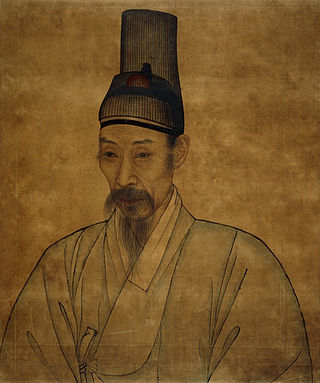
Tanggeon (Korean: 탕건) is a type of Korean traditional headgear worn by men,which is put under a gat,and worn over their topknot (sangtu). It is usually made of dyed horsehair or cow hair. Artisans who specialize in making tanggeon are called tanggeonjang.

Jipsin (Korean: 짚신) are Korean traditional sandals made of straw. Koreans have worn straw sandals since ancient times. They are categorized as 이;履;yi,shoes with a short height,and the specific name can vary according to the materials used,as with samsin,wanggolsin,cheongol jisin,and budeulsin.

Tarak-juk,also called uyu-juk or milk porridge,is a juk,or Korean porridge,made with milk and rice. It was a part of the Korean royal court cuisine and was also patronized by yangban (scholarly-officials).

The Eumsik dimibang (Korean: 음식디미방) or Gyugon siuibang (규곤시의방) is a Korean cookbook written around 1670 by Jang Gye-hyang,during the Joseon period. The author was in the noble yangban class and the book is a manuscript written in Hangul.
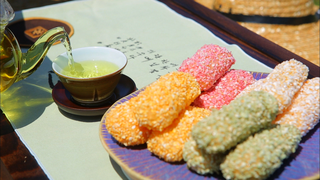
Gangjeong (Korean: 강정) is a hangwa made with glutinous rice flour. It is a deep-fried "rice puff" with hollow inside,coated with honey followed by nutty beans,nuts,seeds,pollen,or spice powders. Gangjeong is often served during important events such as weddings,ancestral rites,and Korean New Year celebrations. Yugwa was widely distributed after the Goryeo dynasty due to the influence of Buddhism,and was called "Goryeo dessert" in the Yuan dynasty of China.

Yoon Sook-ja is a South Korean cooking researcher and professor.
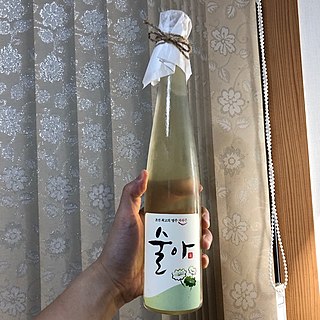
Gwaha-ju is a traditional Korean fortified rice wine. The refined rice wine cheongju is fortified by adding the distilled spirit soju to produce gwaha-ju. Popular varieties include gangha-ju (강하주) of Boseong and Yeonggwang in South Jeolla Province,sinseon-ju (신선주) of Namwon in North Jeolla Province,and yak-soju (약소주) of Suwon in Gyeonggi Province.

Cosmetics have been used in Korea since antiquity. Today,cosmetics are an important industry in South Korea.
Yi Bingheogak was a Korean female scholar who wrote "Gyuhapchongseo","CheongGyuBakMulGi",and "Bingheogakgo" in the late Joseon Dynasty.

Injeolmi is a variety of tteok,or Korean rice cake,made by steaming and pounding glutinous rice flour,which is shaped into small pieces and usually covered with steamed powdered dried beans or other ingredients.

K-beauty is an umbrella term for skincare products that are derived from South Korea. The fad gained popularity worldwide,especially in East Asia,Southeast Asia,South Asia,and the Western world,and focuses on health,hydration,and an emphasis on brightening effects.

Dadeumi (Korean: 다듬이) or dadeumijil (다듬이질) is a Korean traditional ironing method where two women knelt on the floor,facing each other across a smoothing stone,beating out a rhythm on the cloth to press out its wrinkles and soften it. Dadeumi requires dadeumitbangmangi (다듬잇방망이) and dadeumitdol (다듬잇돌). The former is a bat that pounds on the cloth,and the latter is the stone under the cloth.



















